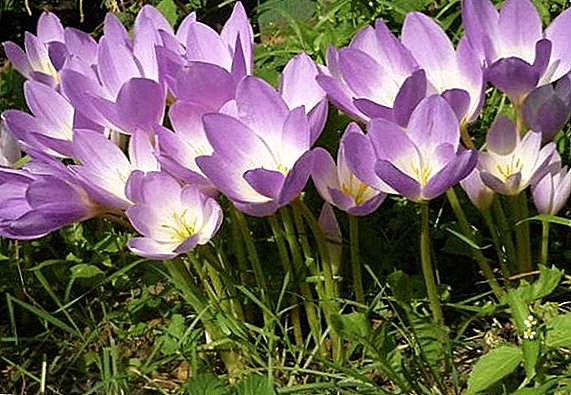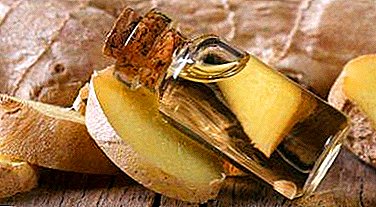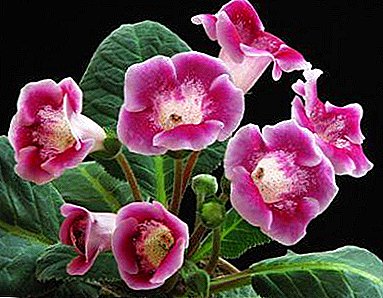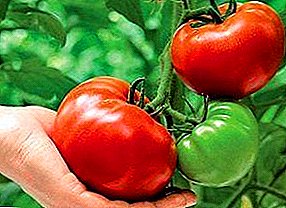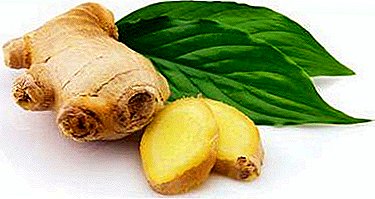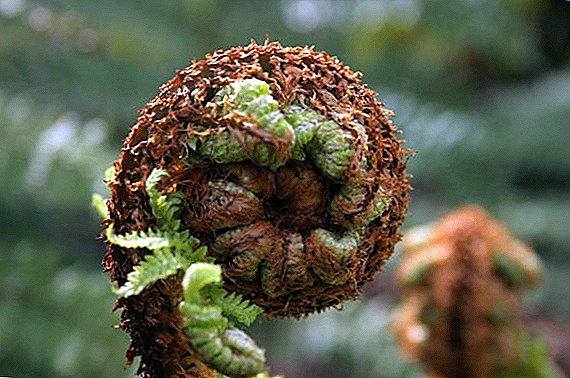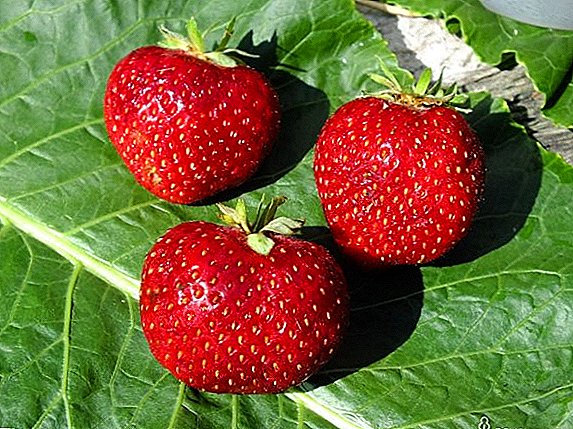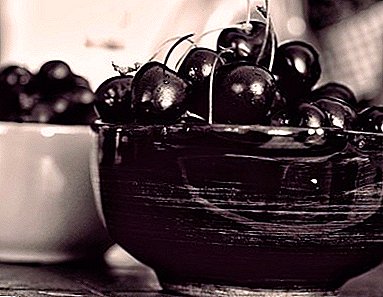
Such a fruit crop as a cherry is widely known and popular for a long time. Its juicy fruits are suitable not only for consumption, but also possess a lot of useful properties and contain a large number of trace elements.
To date, over 200 varieties of this fruit tree can be counted. One of the many varieties is Cherry Rossoshanskaya black. Description of the variety and photo of the fruit in the article.
Breeding history and breeding region
 According to some data, parental varieties are Consumer Black and Rossoshanskaya.
According to some data, parental varieties are Consumer Black and Rossoshanskaya.
A new species was obtained by sowing a locally freely pollinated variety. at Rossoshanskoy experimental station them. A. Ya. Voronchikhina. By the way, the hand of this breeder, after whom the station is named, belongs to the varieties Nadezhda, Black Large.
After removing the black Rossoshanskaya cherry was widely used in homestead and industrial areas.
Since 1986 Lower Volga region, and North Caucasus and Central Black Earth became the main areas in which this variety is cultivated.
Morozovka, In memory of Enikeeva, Zhivitsa and Turgenevka also grow successfully in these regions.
Appearance of cherry Rossoshanskaya Black
Consider separately the appearance of the tree and the fruits themselves.
Tree
Mature tree does not exceed four metersthat is the undoubted advantage of this variety. The crown has a characteristic pyramidal-stag form. Branches do not grow densely, have a medium or small percentage of foliage.
Young trees are distinguished by the gray color of the bark, while the bark of the old trees darkens considerably. The surface of the bark is smooth with a slight roughness, resistant to cracking along the trunk.
 Formations in the tissue of the stem, called lentils, convex relative to the trunk of the tree.
Formations in the tissue of the stem, called lentils, convex relative to the trunk of the tree.
Their length varies from medium size to long, frequency and width within the normal range. The crookedness characteristic of almost all deciduous trees on a cherry is missing.
The main skeletal branches of the first and second order tend to become bare over time.
The shoots of young trees are brown-green in color, which grows into gray with longitudinal stripes with age.
The shoots themselves are usually straight, and more rarely somewhat curved, have several longitudinal gray lentils.
Vegetative buds in this variety are very large, convex, egg-shaped cherries about 4-5 mm in size. Generative buds are similar in size and shape. Leaves slightly pointed at the end, brilliant green.
The height of the leaf is up to 10 cm, while the width of the leaf reaches 4-5 cm. The inflorescences consist of two or three flowers resembling a bowl. Petals are round white, becoming almost pink by the end of flowering.
Fetus
The appearance of the berries is a hallmark of the variety. By color fruits are almost black, with a touch of red. Large berriesusually round, but often oval. With slightly flattened sides.
Dark fruits are also available in varieties of Black Large, Chernokorka and Chocolate.
 The flesh of the berries of the same dark red color, fleshy, rather dense, with a juice of red.
The flesh of the berries of the same dark red color, fleshy, rather dense, with a juice of red.
By tasting the berries got 4.5 points for a pleasant sweet-sour taste.
Bone in a medium sized berry, in relation to the pulp is 7%, medium separable from the fruit, beige in color with a slight redness.
Content of substances:
| Composition | amount |
|---|---|
| Sahara | 12% |
| Titrated acids | up to 1.9% |
| Tanning and coloring agents | from 0.1 to 0.2% |
REFERENCE: In fully ripe berries, the stalk is detached from the flesh without damage. While the unripe berry gives off the juice when taken off.
A photo





Characteristics of a variety
The strength of this variety of cherry is good. But often for better fruit ovary, additional pollination is required. Flowering begins rather late, the fruits fully ripen in Central Black Earth regions in late June.
Cherries are loved by many gardeners for her fast fruiting. Trees grafted onto wild species of cherries, mainly antipku, are beginning to actively bear fruit for the third year. In the fourth year of landing you can get up to 7 kg yield.
Ashinskaya, Genedraya, Tsarevna and Uralskaya Rubinovaya demonstrate excellent yields.
But the development of fruiting takes a long time, and full-scale harvesting comes after six years old minimum.
 The average yield of cherries is 15.5 kg ripe berries. In particularly favorable years, fruit harvesting was almost 25 kg per tree.
The average yield of cherries is 15.5 kg ripe berries. In particularly favorable years, fruit harvesting was almost 25 kg per tree.
Frost resistance in native regions of this tree is quite high. The degree of freezing at very low temperatures was about 1 point for several years of research.
A good winter hardiness is also demonstrated by Tamaris, Fairy, Vladimirskaya and Rovesnitsa.
Planting and care
This variety of cherry grown in the regions of the middle lane is enough resistant to low temperatures. But the main danger frosts are for the kidneyswhich are more sensitive to cold.
During even short-term thaws and in the second half of winter, the kidneys are able to wake up and become very vulnerable to new frosts. Damage during flowering during unexpected night frosts is also frequent.
ATTENTION: The crop most often dies if the trees are located in a lowland, where cold air often stagnates. Therefore, an important rule when planting cherries is mandatory elevation and protection from the wind.
Place for planting heat-loving cherries should choose on high hills or near the brick wallwhich, accumulating heat, will give it to the tree. For the winter, the trunk trunks need Cover with a breathable cloth.
 Cherry seedlings better to plant in spring, as long-standing shoots can easily freeze out in winter. If the purchased seedlings the roots are damaged, they need to be cut off, to the healthy part.
Cherry seedlings better to plant in spring, as long-standing shoots can easily freeze out in winter. If the purchased seedlings the roots are damaged, they need to be cut off, to the healthy part.
Young trees are planted, given the distance from outbuildings and other trees, which should not be less than two meters. Pit for planting depth should be 40-45 cm, width about 60 cm.
Dug earth from the pit must be mixed with a certain amount humus, a kilogram of ash, phosphate in the range of 50 g and 20-25 g of potassium chloride.
The soil must have the necessary drainage, Stagnant water must not be allowed.
Before landing pit shed two or three buckets of water. After the water is completely absorbed, the seedling will be ready for planting.
Around the young tree You should build a small earthen roller, which will form a hole for watering. The soil in a small radius around the cherry is necessary to mulch sawdust to protect the ground from excessive drying.
Cherries do not require special care. Just as for all fruit trees, the main ones remain watering, loosening the soil, destroying weeds, timely feeding and protective measures against pests. Especially nutrients cherry needs in the period of its fruiting.
REFERENCE: A sapling will not need special fertilizers for almost three years if they were applied during planting.
 Like another fruit tree, Cherry needs pruning.
Like another fruit tree, Cherry needs pruning.
Over time, the trunk begins to form a mass of small twigs that appear every year.
If the branches grow in the direction of the crown of the trunk, they should be removed.
You also need to make sure that the stem stem does not become below the permissible 40 cm.
Timely pruning forms the correct crown and gives a guarantee against chopping the fruit.
ATTENTION: The length of the branches should not be longer than 50 cm. Extra centimeters will need to be removed in the spring three weeks before the buds begin to swell.
Cherry is considered drought resistant culture. But the presence of water in the soil is necessary for any plant. This variety needs to be irrigated four times during the growing season.
The time of first watering usually falls on the period after flowering, the second occurs during the fruit ovary, the third is needed after harvest, and the fourth, winter, no later than the fourth week of October. For one watering in the hole you need to pour two to four buckets of water.
Diseases and pests
 Caterpillars and green aphids - The main enemies of the cherry tree.
Caterpillars and green aphids - The main enemies of the cherry tree.
In order to prevent the parasites from damaging the tree in time, it is necessary to inspect the trunk more often and remove and destroy the caterpillars when detected.
If there is a massive defeat, then special ones can help. chemical spraying.
Also this variety has a very low resistance to fungal diseases, among which coccomycosis.
The disease manifests itself in premature yellowing and soon falling leaves. The development of the fungus is very conducive to wet weather. Spray with the addition of copper spend two or three times. As a rule, this gives one hundred percent protection.
Hope, Vianok and Zhukovskaya are highly resistant to coccomycosis.
Another fungal disease to which this variety is highly susceptible is monilioz Manifested in burn lesions of branches and wood in general. Productivity at the same time falls almost to zero.
Means of struggle are three times fungicide treatments. These are the most basic and dangerous fungal diseases of the cherry tree.
The remaining diseases, based on the fungus, are treated with similar drugs.
Disease prevention
- Competent care
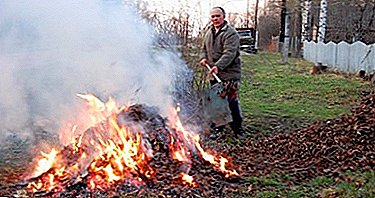 Burning affected leaves and twigs that are carriers of the disease.
Burning affected leaves and twigs that are carriers of the disease.- Pruning only in dry and windless weather.
- Spring pruning of extra branches.
- Fertilize only weedy areas under the tree.
- Limy whitewashing of the trunk will prevent sunburn.
- To carry out prophylactic planned spraying.
Black Rossoshanskaya cherry is universal in its type of use. The grade received the greatest estimation as the best for preparation of compotes both for tastes, and for the appearance.


 Burning affected leaves and twigs that are carriers of the disease.
Burning affected leaves and twigs that are carriers of the disease.